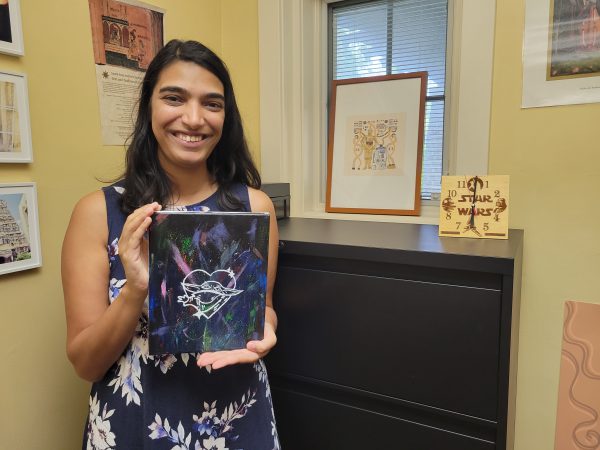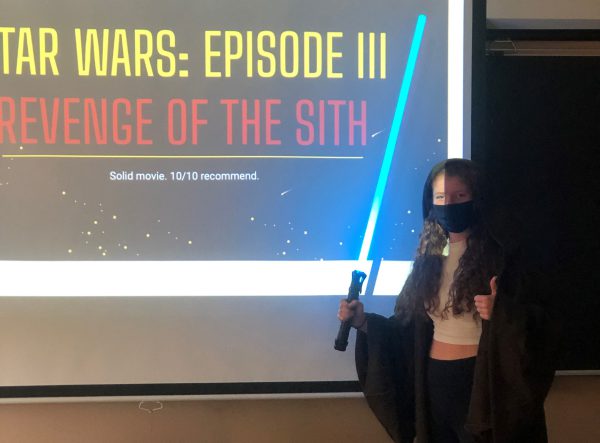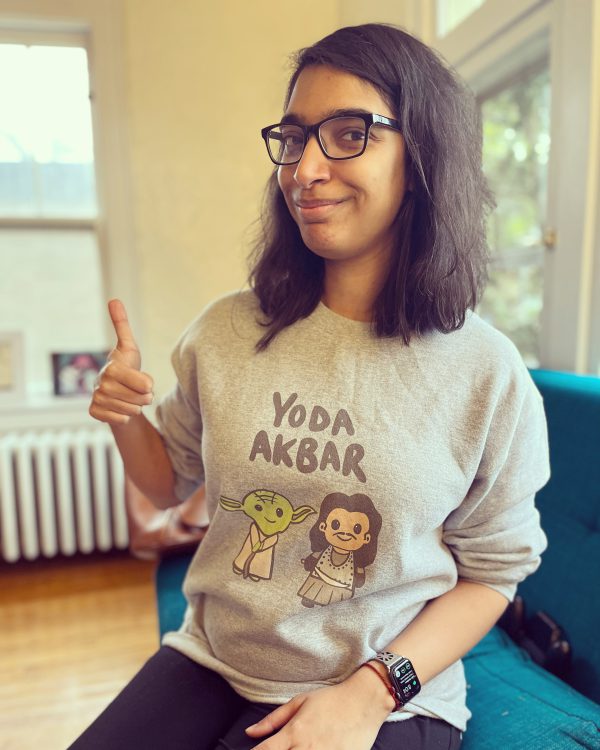


Some Kalamazoo College students will learn the ways of the Force this fall in a new Star Wars-themed class that examines religion’s role in the franchise.
Students in Jedi, Sith, and Mandalorians: Religion and Star Wars, taught by Assistant Professor of Religion Sohini Pillai, will watch seven of the films along with The Mandalorian Disney+ series, and read from books such as The Tao of Yoda, The Gospel According to Star Wars: Faith, Hope and the Force, and The Myth Awakens before writing a research paper in which they analyze a Star Wars film or show not discussed in class.
Their goals are to gain a better understanding of religious, cultural and historical contexts related to Star Wars while investigating key concepts in the study of religion such as canonization, myth, invented vs. traditional religions, cultural appropriation, colonization, indigenous cultures, orientalism and racism.
“There are so many themes in the Star Wars universe that are applicable to the study of religion,” Pillai said. “Just in the first week, for example, we’re going to be talking about orientalism and the exoticization of the Eastern world. The world of Tatooine was filmed in Tunisia and the whole planet is essentially based on the Middle East, the Ewoks speak in highspeed Tibetan, and many of the characters have names based on Sanskrit words. I’m really looking forward to it.”
The idea for the course developed not so long ago, in a classroom not so far away, when—in 2021—Pillai began teaching a First-Year Seminar, Epic Epics. The class used The Odyssey of Star Wars: An Epic Poem, along with nine other narratives about a variety of heroic warriors and colossal battles, to examine how such stories have changed over time and influenced cultures.
Revenge of the Sith, a Star Wars prequel released in 2005, took center stage in final presentations that term with two students reflecting on the film through themes found in the epics. One of the students, Paige Anderson ’25, even offered her presentation while wearing Jedi robes and wielding a lightsaber. The conversations from those presentations and throughout the term pleased Pillai, who also is K’s director of film and media studies.
“Those students are hardcore Star Wars fans,” she said. “I was especially surprised by how much they loved the prequel trilogy. The story, if you haven’t seen the original Star Wars movies, is compelling and exciting. It’s a story about Anakin Skywalker turning to the Dark Side to become Darth Vader. But my students would have been in high school and middle school when the sequel trilogy came out. I thought they would’ve liked those more.”
Regardless of their favorite movies in the franchise, it was evident that student interest, not to mention her own fandom, could help Pillai develop Jedi, Sith, and Mandalorians: Religion and Star Wars. Pillai said she remembers first being interested in the Star Wars universe when she was in kindergarten and her parents introduced her to the first three films after she heard about the films from a classmate. When she was 9, The Phantom Menace, the original prequel, was the first Star Wars movie she saw in theaters. Today, her fandom continues with a variety of merchandise in her office, the Disney+ streaming shows, and an Instagram-famous Yorkshire terrier, Leia, named after the princess who is Pillai’s favorite character in the franchise.
“I distinctly remember growing up and seeing movies like The Little Mermaid, Cinderella, and Sleeping Beauty where these princesses are basically sitting there and doing nothing,” she said. “And then in kindergarten, seeing Princess Leia with a blaster and defending herself while also being a diplomat and speaking so eloquently, I was impressed by her. I think she’s one of the most incredible female characters in cinema. I liked the idea of Padmé being a queen at the age of 14, and I enjoyed Rey’s character in the new trilogy as well. And speaking of the new Ahsoka show, I love that three women including two women of color are leading it.”
If you were concerned that some in and around K would question the value of a Star Wars class in the curriculum, Darth Vader—and Pillai, for that matter—might say, “I find your lack of faith disturbing.”
“I remember in the faculty meeting when we were voting on new classes that about 10 people all at once seconded the motion to adopt the course,” Pillai said. “I’ve had a lot of people—like Director of Athletics Becky Hall—say, ‘Send me the syllabus! I want to sit in on the class.’ I think there’s a lot of excitement for this. K has a solid Star Wars community.”


The broader K community, from staff to alumni and beyond, has been equally supportive. One recent Twitter/X post said, “As a @kcollege alum, I am stone cold jealous of the students taking this class.” Another said, “The fact that I graduated from @kcollege 30 years too late to take this class is a big disappointment to me as a #StarWars fanatic!”
Then there are the junior and senior K students who didn’t exactly have to be scruffy-looking nerf-herders to realize that the course would be fun, entertaining, and educational as they filled the last seats in it during the second day of fall registration.
Pillai can’t be certain that Jedi, Sith, and Mandalorians: Religion and Star Wars will be offered again. As Yoda would state, it’s “difficult to say; always in motion is the future.” She hopes, however, that first-year students, sophomores, and students on study abroad this term will have opportunities to register for it, too.
“I’ll probably want to teach it again because I imagine it’s going to be super fun for me,” Pillai said. “In the future, I think I’m going to have to reserve spots for underclassmen because I feel bad that they weren’t able to take it this time around. But it’s great we have so much interest in it. I think that Star Wars can be used as an important teaching tool, especially in the world that we live in.”
